
Most Popular Desserts and Drinks in Beijing
No meal is complete without a sweet touch and a proper drink to wash it all down. Beijing's food scene is rich and colorful in many ways, and the dessert & drink areas are no exception. Some of the signature Beijing delicacies have gained popularity across Asia over the centuries, whereas other "traditional" Beijing sweets have been "borrowed" from other countries. Finding out the roots is a feeble attempt sometimes, but tasting it sounds like a real plan. Charted here are some of the major sweet-tasting landmarks of the Chinese capital worth exploring.
(To visit the venues mentioned in this article, check out these Self-Guided Walking Tours in Beijing)
1. Steamed Cone-shaped Cake ( Aiwowo, or 艾窝窝)
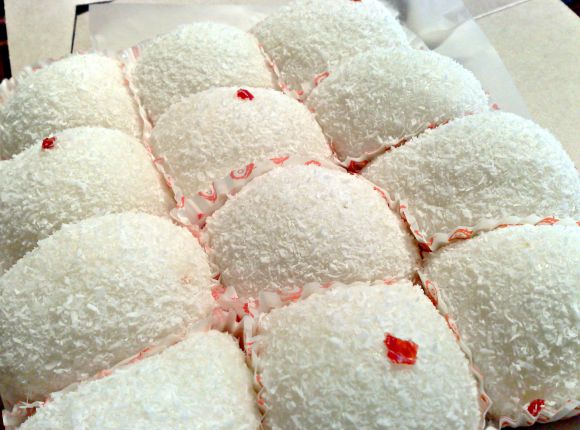.jpg)
Image Courtesy of: 松林 L
Muslim culture in Beijing is partially manifested in the form of this traditional ball-shaped sweet delicacy, dating back as far as the Ming Dynasty period. Its recipe involves glutinous rice sprinkled with sesame and walnut seeds, however, disagreement over its origin still provokes heated debate even today. Some say Aiwowo was invented in Beijing; others insist it was brought in from Xinjiang province, whereas monks of the recently re-embraced Hong Kong territory claim it's been theirs (i.e. Cantonese) since times immemorial. For all they know, common Beijingers couldn't have cared less and continue eating it as a local specialty. Whenever you're in Beijing, bother not to join into the debate but, instead, do as Beijingers do – if it looks good, eat it!
2. Tanghulu ( 糖葫芦 )
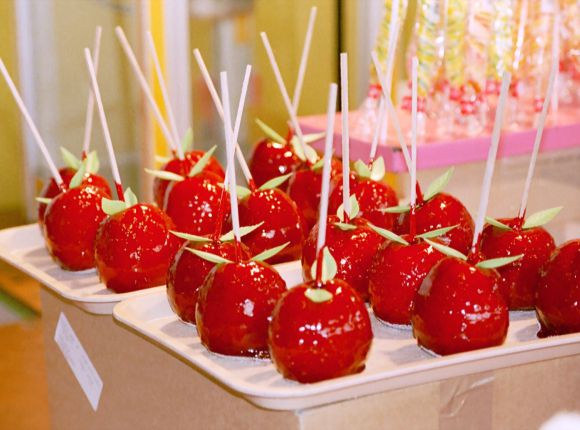.jpg)
Image Courtesy of: Greudin
Crabapple on a skewer, coated in dried liquid sugar is what they call Tanghulu, or the "Chinese toffee apple". Strongly resembling Western Chupa Chups (or, maybe, it's the other way around), this is just one of the possible, and most common, varieties of an old Beijing-style sweet. Other varieties include other fruits, such as kiwi and grapes, for example, and are widely sold across the city on food markets and streets, particularly near major tourist landmarks. Carts laden with these snacks are commonly parked on the side of the road so you won't miss it.
3. Tea ( 茶 )
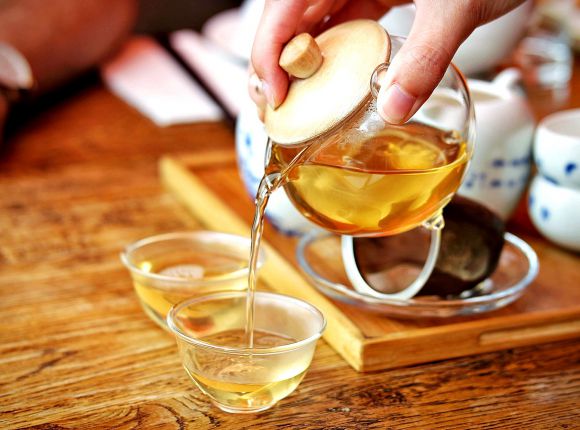.jpg)
Image Courtesy of: insatiablemunch
China is the craddle of the world's tea culture. The delicate fragrance and distinct flavour of this drink has been enjoyed by the Chinese for over a thousand years. Originally a medicine, eventually tea has evolved into an everyday beverage and serving it has become a formal custom. Whether you're a green-, black-, red- or flower tea fan, you can find all of these teas in great variety in numerous tea houses across Beijing and further afield.
A Chinese tea house (茶館, "cháguăn" or 茶屋, "cháwū"), in a way, is similar to American cafe; only the former is centered around tea, whilst the latter - around coffee. This is also a gathering place where people come to mingle, drink tea and enjoy themselves as well as each other's company. Young ones often set up a date there. Whenever the pace of life in Beijing proves too fast for you, have a break. Come to a tea house and sit back and watch the life go by for a while. Whilst at it, you can enjoy some of the finest teas imaginable on this planet, complete with traditional Chinese snack food.
A Chinese tea house (茶館, "cháguăn" or 茶屋, "cháwū"), in a way, is similar to American cafe; only the former is centered around tea, whilst the latter - around coffee. This is also a gathering place where people come to mingle, drink tea and enjoy themselves as well as each other's company. Young ones often set up a date there. Whenever the pace of life in Beijing proves too fast for you, have a break. Come to a tea house and sit back and watch the life go by for a while. Whilst at it, you can enjoy some of the finest teas imaginable on this planet, complete with traditional Chinese snack food.
4. Egg Tarts

Image Courtesy of: Alpha
This is probably what the Chinese got in exchange for their noodles from the Portuguese who colonized Macau and therefrom introduced egg tarts to mainland China. In essence, this is just a little custard tart, distinct for its hard and sweet crust, rather common in Western European cuisines. In keeping with the original, Chinese egg tarts are best eaten warm, which is something local restaurants, mostly Cantonese-style, encourage diners to do.
Other than restaurants, egg tarts have also established themselves strongly with many shops, some of which (mostly, the hole-in-the-wall type) have gone as far as to make these their prime specialty. Some convenience stores sell egg tarts as well, in large quantities and pre-heated. A good option for grab-and-go snack while sightseeing in Beijing!
Other than restaurants, egg tarts have also established themselves strongly with many shops, some of which (mostly, the hole-in-the-wall type) have gone as far as to make these their prime specialty. Some convenience stores sell egg tarts as well, in large quantities and pre-heated. A good option for grab-and-go snack while sightseeing in Beijing!
5. Soybean Milk (Du Jiang, 豆浆)
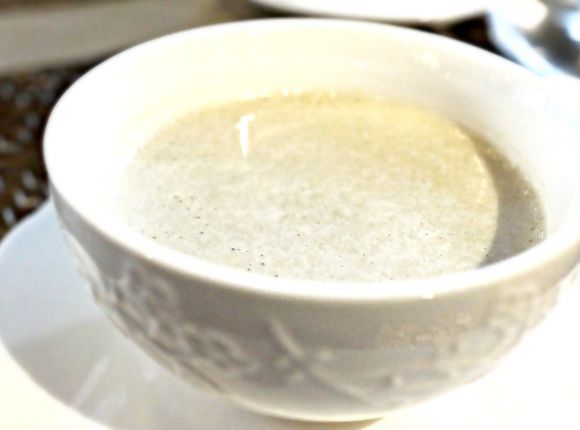.jpg)
Image Courtesy of: 挪威 企鵝
Soy is big in China and Soybean milk (Du Jiang, 豆浆), in particular, is very much active an element on the local food scene. Having about the same proportion of protein as cow milk, it does for the traditional Chinese breakfast pretty much what milk tea does for the English, and with great success, especially if combined with various pastries, such as mantou (steamed bun), youtiao (deep-fried dough), and shaobing (sesame flatbread). Soybean milk can be both sweet and salty, but sweet version is more preferred by the locals. The milk is made of soaked dry soybeans, grinded with water. All soy milk and honey... wonder if that could be a vegan metaphor for paradise???
6. Dragon's Beard Candy (龙须糖 )
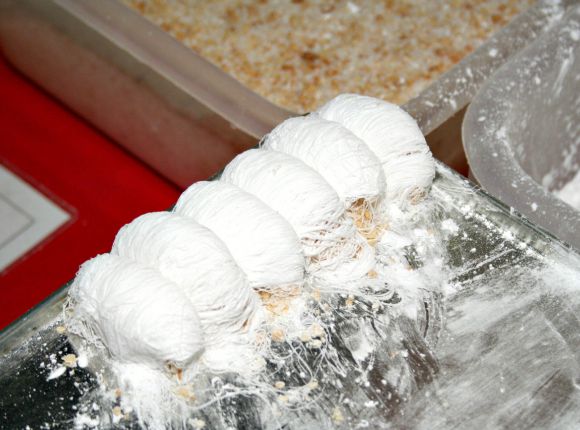.jpg)
Image Courtesy of: Dragon Beard Candy - Sydney Australia
"Who told me dragons did not exist, then led me to their lairs..." Spooky, huh. But worry not when they offer you to try Dragon's Beard Candy in Beijing. The dragons they use for making this sweet are well tamed and are part of a traditional Chinese art that originated under the Han Dynasty centuries ago.
The actual "beard hairs" resemble candy floss and are made of spun sugar – rather sticky to touch. It gets even stickier if exposed to heat, and just as easily melts, so, perhaps, the best place to "store" it is in one's mouth. You will find this snack sold in abundance on the streets of Beijing; just pay attention to those vendors on the side of the road or stalls near popular tourist locations.
The actual "beard hairs" resemble candy floss and are made of spun sugar – rather sticky to touch. It gets even stickier if exposed to heat, and just as easily melts, so, perhaps, the best place to "store" it is in one's mouth. You will find this snack sold in abundance on the streets of Beijing; just pay attention to those vendors on the side of the road or stalls near popular tourist locations.
7. Pumpkin Pancake ( Nangua Bing, 南瓜饼 )
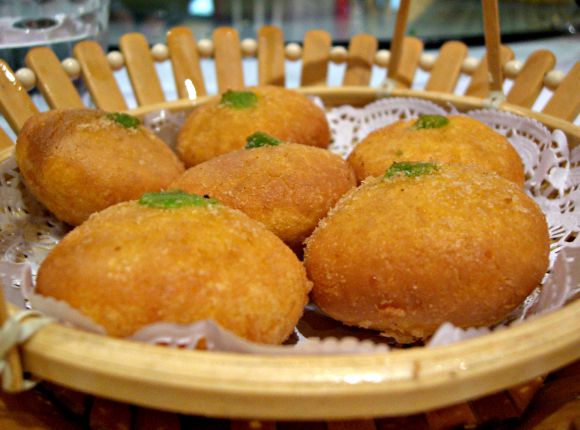.jpg)
Image Courtesy of: Alpha
Another Chinese pancake that doesn't look anything like a pancake is the so-called pumpkin pancake or Nangua Bing, originated in the Sichuan province. You will find these in most Sichuan-style restaurants, as well as any other major restaurants in Beijing, for that matter, because the popularity of this snack demands so.
Cooking it is relatively easy and involves deep frying in oil pancakes that are made predominantly of pumpkin, sugar, and flour. This is a popular winter snack throughout China and, perhaps, one of the sweetest things ever produced for public consumption. If you're not a sweet tooth yourself, beware as these may prove a bit too sweet for your palate. On some occasions, for extra taste and texture, they add roasted sesame seeds to the coating.
Cooking it is relatively easy and involves deep frying in oil pancakes that are made predominantly of pumpkin, sugar, and flour. This is a popular winter snack throughout China and, perhaps, one of the sweetest things ever produced for public consumption. If you're not a sweet tooth yourself, beware as these may prove a bit too sweet for your palate. On some occasions, for extra taste and texture, they add roasted sesame seeds to the coating.
8. Tangyuan ( 汤圆 )
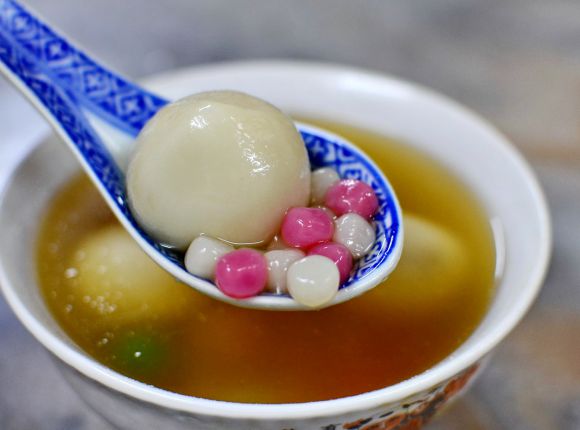.jpg)
Image Courtesy of: SAM Cheong
Another Sichuanese invention that has made its way to the Beijing food tradition is Tangyuan. This warm soup, sweet and filled with fermented rice and sticky rice balls, is a major entry on any Sichuanese restaurant's menu. Oftentimes, due to the presence of fermented rice, it may appear somewhat alcoholic and tasting like Southern Chinese mijiu, or rice wine. Caution if you set out to drive afterwards! This soup is usually eaten at large family gatherings, hence its name, resembling the term for 'family reunion' (tuanyuan twan-wyen 团圆).
9. Pearl Milk Tea ( 珍珠奶茶 )
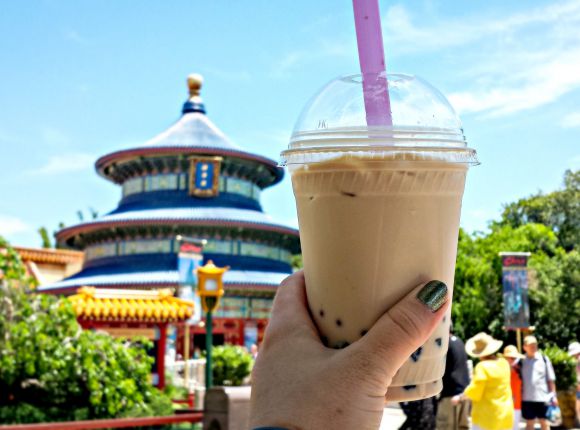.jpg)
Image Courtesy of: Anna Fox
If soy milk alone doesn't stand much of a chance with you as a tangible milk replacement, then, perhaps, you should turn to pearl milk for a change... or, rather, pearl milk tea – one of the latest soft drink hits with the Chinese youngsters, imported from Taiwan. Never mind that you're not a youngster yourself anymore or Chinese... Trying it won't hurt! The drink features jelly or pudding-like bubbles in sweetened milk tea and leaves a slightly bitter aftertaste. Bittersweet, ahh...
10. Grass Jelly

Image Courtesy of: Sjschen
Perhaps, some of the weirdest of Chinese sweets to the Western taste is the grass jelly, which, in turn, is the most commonly eaten jelly dessert in China. Not only is it popular here, but also across Southeast Asia and Taiwan. To make it, they use boiled 'fairy grass' (仙草 i.e. mesona chinensis, the type of mint) in combination with starch and baking salt. You may not like the taste, but fresh breath is guaranteed! Other than jelly, this grass jelly thing can be consumed in many other forms, including liquid (as a drink), or mixed with condensed milk, which is rather popular dessert served in Chinese restaurants.
11. Sour Plum Drink ( Suanmeitang. 酸梅汤 )
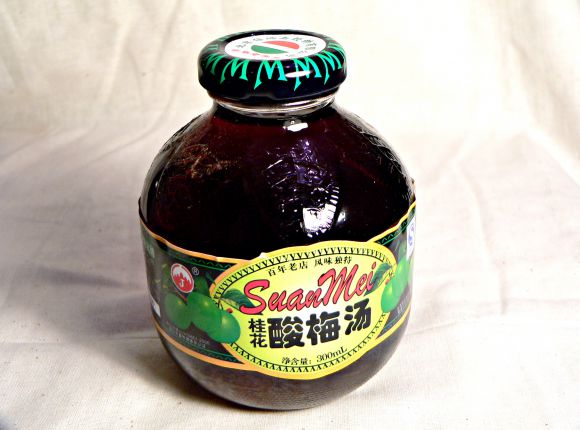.jpg)
Image Courtesy of: 用心阁/Yongxinge
Suanmeitang, or sour prune drink, is definitely for those who don't mind having things turn a bit sour from time to time. Made of sour plums (specifically, smoked Chinese plums) - hence the name, this traditional Chinese beverage also contains rock sugar, sweet osmanthus and other ingredients. Because of the sour plums present, it tastes somewhat salty, whilst sweet and sour at the same time. Suanmeitang is a commercial success in China and other parts of the globe where Chinese community is present in sufficient proportion. It is particularly liked chilled in summer, as a relief from the heat, and is one of the most popular summer drinks in China. However, Suanmeitang owes its popularity not just to cooling effects, but also to the health benefits it is believed to provide, e.g. improving digestion and possibly inhibiting the build-up of lactic acid in a body. Who knows? The only way to find out is to have a sip.
12. 'Rolling Donkey' (Lu Da Gun)
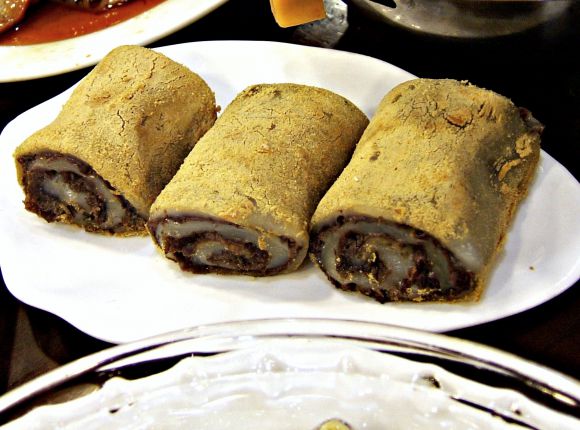.jpg)
Image Courtesy of: Toby Oxborrow
"Rollin rollin rollin..." The donkey theme got attached to this cake because of the way it is rolled in fried soybean flour, resembling a donkey rolling about in dust... Or, perhaps, this is due to the similarity in appearance with rawhide afterwards. Either way, this rice-flour yellow-looking cake is a traditional Beijing sweet.
Its cooking process involves, first, putting the steamed glutinous millet or sticky rice dumplings into fried soybean flour and then adding some sweetened bean paste. Upon that, the dumplings get rolled out and then rolled up and cut into cake pieces. The ones prepared properly should taste sweet and have a sticky texture. If you get a chance, go give the donkey a bite!
Its cooking process involves, first, putting the steamed glutinous millet or sticky rice dumplings into fried soybean flour and then adding some sweetened bean paste. Upon that, the dumplings get rolled out and then rolled up and cut into cake pieces. The ones prepared properly should taste sweet and have a sticky texture. If you get a chance, go give the donkey a bite!
13. Tsingtao Beer

Image Courtesy of: Tommie Hansen
Tsingtao is the most internationally recognized Chinese brew, sold in 62 countries worldwide. This German-style lager boasts high-malt flavor with a hint of hops, is easy to drink, and leaves no bitter aftertaste. The beer is produced in the seaside city of Qingdao, for which purpose they use spring water from Laoshan in the Shandong province, a mountain area renowned for its pure water. Lovers of beer can find Tsingtao in most any restaurant, supermarket or convenience store throughout China. A pure delight on a hot summer day - Cheers!!!
Get GPSmyCity App for IOS or Android
You can read offline thousands of travel articles like this one in the "GPSmyCity: Walks in 1K+ Cities" app on Apple App Store or Google Play Store. The apps also offer city offline maps and GPS navigation to guide you to the places featured in the articles.
Walking Tours in Beijing, China
Create Your Own Walk in Beijing
Creating your own self-guided walk in Beijing is easy and fun. Choose the city attractions that you want to see and a walk route map will be created just for you. You can even set your hotel as the start point of the walk.
Beijing's Historical Temples Tour II
The places of worship are some of the best links to the city's history. The unique churches, Buddhist and Taoist Temples, and beautiful Muslim Mosques all tell great tales of the history of Beijing. Despite that many of them have been partially or completely destroyed over the years either by wars or by the changes of political power, a good number of them still remain. You can visit a few... view more
Tour Duration: 1 Hour(s)
Travel Distance: 2.1 Km or 1.3 Miles
Tour Duration: 1 Hour(s)
Travel Distance: 2.1 Km or 1.3 Miles
Beijing City Center Walking Tour
A political, cultural, and economic center of China for the past eight centuries, Beijing is the newest of the country's Four Ancient Capitals.
The city boasts the grandest and best preserved imperial palaces, gardens and temples, including seven UNESCO World Heritage sites, such as the Forbidden City, Temple of Heaven, Summer Palace, Ming Tombs, Zhoukoudian, and parts of the Great Wall... view more
Tour Duration: 2 Hour(s)
Travel Distance: 3.7 Km or 2.3 Miles
The city boasts the grandest and best preserved imperial palaces, gardens and temples, including seven UNESCO World Heritage sites, such as the Forbidden City, Temple of Heaven, Summer Palace, Ming Tombs, Zhoukoudian, and parts of the Great Wall... view more
Tour Duration: 2 Hour(s)
Travel Distance: 3.7 Km or 2.3 Miles
Olympic Park Walking Tour
The Olympic Park in Beijing was built for the Olympic and Paralympic Games of 2008. This modern complex represents a contemporary architectural approach as compared to the more traditional buildings that dominate the city. Among its signature items are the iconic Bird's Nest, otherwise known as the main Olympic stadium, and the beautiful Water Cube – the Aquatics Center for water sports.
... view more
Tour Duration: 2 Hour(s)
Travel Distance: 5.6 Km or 3.5 Miles
... view more
Tour Duration: 2 Hour(s)
Travel Distance: 5.6 Km or 3.5 Miles
























